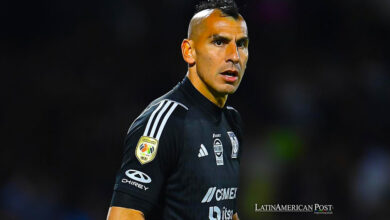Why is the World Cup ball the goalkeepers’ enemy?
Telstar 18 left bad impressions on wardens like De Gea, Ter Stegen, and Reina

Leer en español: ¿Por qué el balón del Mundial es enemigo de los arqueros?
The FIFA international friendly matches, which were held in March, were the stage in which the official ball of the 2018 World Cup Russia, the Telstar 18, was re-tested. The expectations were high, however, the ball did not please the goalkeepers, especially those who were at the match between Germany and Spain. The Telstar 18 will be one of the most discussed elements during the World Cup.
De Gea, Ter Stegen, and Reina upset with the Telstar 18
The goalkeeper of the Spanish National Team and Napoli’s titular goalkeeper from Italy, ‘Pepe’ Reina, harshly criticized the official World Cup ball, the Telstar 18. “It does strange things, has an uncontrollable flight, and is very improvable”, Reina said about how annoyed he is with how light is the ball. “I bet that in the World Cup we will see at least 35 very far goals because there is no one to decipher it”, said the goalkeeper.
Just his partner, David De Gea suffered these anomalies, because the goalkeeper of Spain and Manchester United of England suffered a half distance goal from the German Thomas Müller, ensuring immediately that the ball is very rare.
“It is covered by a plastic film that hinders its grip, and we as goalkeepers are going to have a lot of problems with this ball,” said Reina, who was supported in his remarks by Ter Stegen, goalkeeper of the German national team and FC Barcelona of Spain. “The ball is improvable, it could be better, because it moves a lot, but I think we’re going to have to get used to working with it and try to achieve as much control as possible before the World Cup begins”, said the German goalkeeper.
Telstar 18: not so good for archers but worthy for field players, fans, and technology
The official ball of the 2018 World Cup, the Telstar 18, has great technological characteristics, as it is the first World Cup ball with an NFC chip (Near Field Communication). This technology allows fans to scan the ball with their smartphones, unlocking information, and challenges created by FIFA. The fans were amazed with this technology, which, in some way, includes them on the world stage.
On the other hand, the field players have been satisfied with the Telstar 18, perhaps because those who will suffer with the characteristics of the ball will be the goalkeepers. Lionel Messi, one of the best players in history and Adidas badge, was in the presentation of the ball in November last year. Messi expressed his total pleasure with the ball. “I was lucky to know the ball a little earlier and I got to try it. I like everything about it: the new design, the colors, everything, “said the footballer.
Dani Alves, player of the Brazil National Team, said after the friendly match against Russia that the ball is favorable for those who kick it and not for those who have to stop it. “The ball pleased me, it’s very good, it’s good for the player who kicks, but not for the goalkeepers, but it’s fine, they take away the joy of football”, said Alves. The player made it clear that the biggest beneficiaries of the Telstar 18 are the field players and the goalkeepers are the biggest losers.
World Cup balls do not usually meet expectations
Adidas is the company that makes the balls of the World Cups since 1970, but since 2002 its products have been the epicenter of criticism. In the World Cup of Korea and Japan 2002 the Fevernova ball was used, which was criticized for its size, lightness, and texture.
In Germany 2006 the Teamgeist ball was used, which was differentiated by being the first World Cup ball in not being made up of 32 pentagonal pieces but by 14 curved parts. Several players criticized the ball saying that Teamgeist was very light and that if it got wet, it changed drastically its behavior.
In the World Cup in South Africa 2010, the most criticized ball in the history of the World Cups was used: the Jabulani. “It’s horrible. It seems one of those balls that people buy at the supermarket”, said Brazilian goalkeeper Julio Cesar. Iker Casillas, Spanish goalkeeper, said the ball was like a beach ball, and at the same time his colleague Gianluigi Buffon flatly reproached the ball. “I think it’s a shame to play with a ball like this in such an important tournament,” said the Italian goalkeeper.
In Brazil 2014 the Brazuca was used and this was perhaps the least criticized ball since 1998, because it was manufactured with synthetic materials such as polyurethane. This material allowed that if the ball got wet the behavior of it would not vary drastically.
Adidas and FIFA seem to have taken a step back, as the Telstar 18 has just signed up as one of the biggest controversies of the 2018 World Cup in Russia. There are less than 80 days until the start of the World Cup, so Adidas still has time to make some modifications to the official ball. The controversy is served with the Telstar 18: will the needs of goalkeepers prevail or will those of field players and technology prevail?
LatinAmerican Post | Javier Aldana
Translated from “¿Por qué el balón del Mundial es enemigo de los arqueros?”





